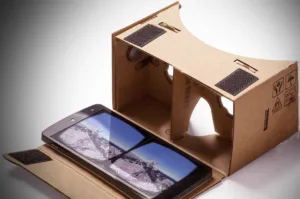As a follow on to its Cardboard viewer and associated Cardboard app, Google has developed, and is now offering, a new virtual reality content creation tool for Android smartphones. Having taken about a year to develop, it is called Cardboard Camera. The app uses computational photography and computer vision techniques to produce a 3D-like experience without the need for capturing the imagery with a special camera.
The 33MB Cardboard Camera app requires use of a smartphone having Android 4.4 or higher. The Cardboard Camera app is available without cost on Google Play. The app can be downloaded without the need for the user to register for an account.
To capture an image, the smartphone is held in the portrait orientation. The user taps the camera button and moves the smartphone from left to right in a full 360º circle. No up or down motion is allowed. The app will indicate if the smartphone is moving too fast. A sample of the ambient sound is recorded as the photo is captured.
When the recording process is finished, a notification is provided to indicate that the imagery is being processed. The extent to which the processing is complete is indicated by a progress bar. It will typically take no more than a few seconds for the imagery to be processed. Completed images are published in the .JPEG format. File size typically ranges from about 4 to 10 MB. This is described as a relatively small file size when compared to the hundreds of megabytes of most immersive VR videos.
Although the resulting images are not truly 3D, the panoramas can be fairly described as 3D-like. To accomplish this effect, the Cardboard Camera app basically works in a way that is similar to one of the now familiar photo sphere apps. That is, the images are stitched together in post-processing and the depth effect is accomplished by presenting each of the user’s eyes with an image captured from a slightly different perspective. In this way, the app has essentially created a stereogram and, it follows, that scenes will appear to have depth when viewed with a Cardboard viewer.
The resulting images can be quite striking: “a three-dimensional panorama where near things look near, far things look far, and you can look in front of you, to your sides, or crane your neck all the way behind you to see the entire captured scene. The top and bottom parts of the image are still empty.”
The current version of the app lacks one significant feature: the ability for users to share their images. At this time, the only way to let someone else see one of your VR pictures is to physically give them a Google Cardboard unit containing the smartphone that actually captured a particular scene.
The Cardboard Camera app can support headsets other than the Cardboard viewer. It has been reported that the Cardboard Camera app will likely be available for iOS sometime during the coming weeks. – Arthur Berman

